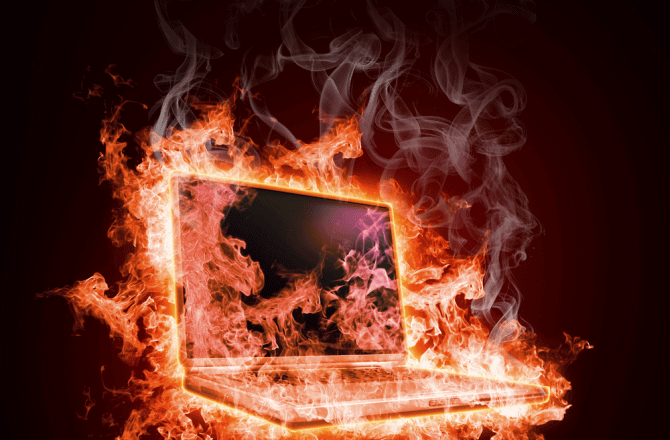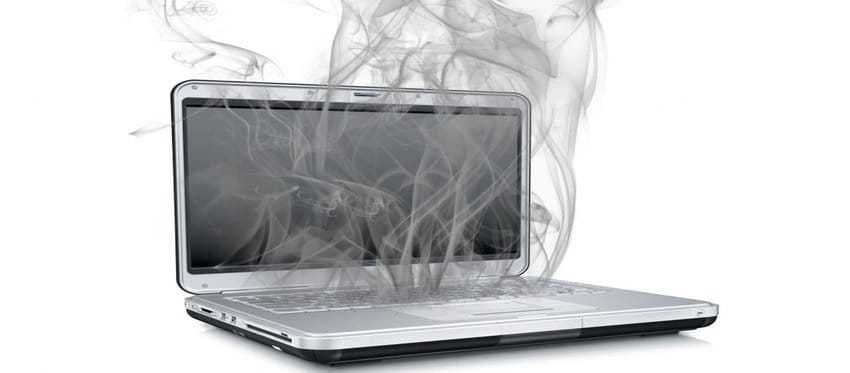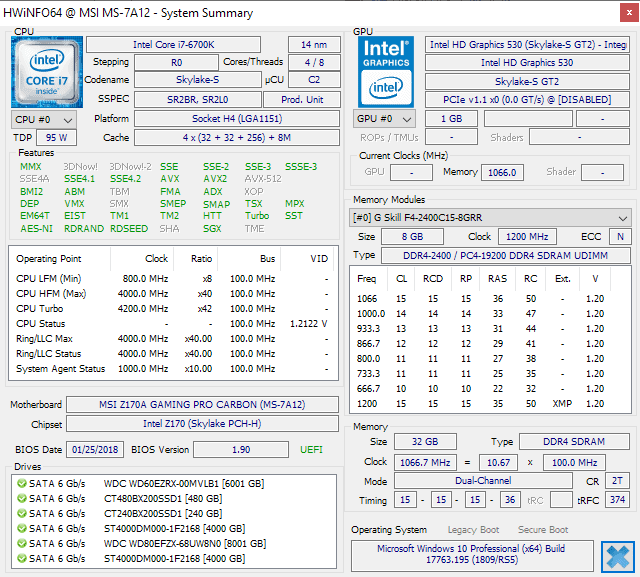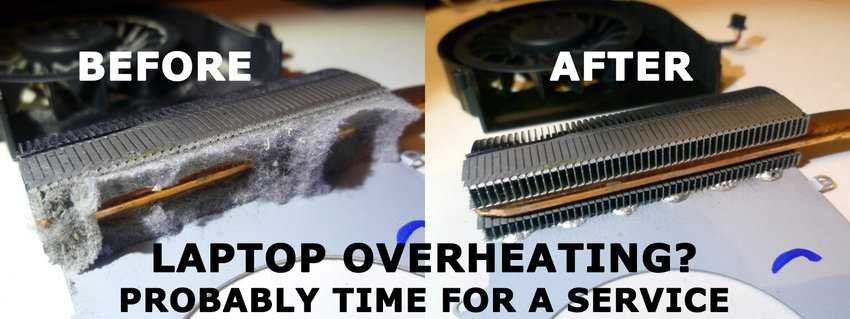Excessive heat can damage the performance and life of your computer. What is the limit we consider to be overheating?

Worried about your computer temperature? You are rightly concerned, because too much heat can affect the performance of your device and the life of your hard drive.
But how do you know if your machine is overheating or just too hot? What is the right temperature for your processor? And what are the signs to look out for that indicate your computer is reaching temperature limits?
How does your computer generate heat?
Heat is a natural by-product of electricity. Anything that uses electricity, whether it is a computer, a car engine, or our body, results in the transfer of heat due to the movement of electrons. The amount of electricity required depends on the work to be performed.
The components inside your computer dissipate heat easily, especially the Central Processing Unit (CPU) and the Graphics Processing Unit (GPU), as electricity flows through their circuits and finds resistance.

For example, overclocking generates too much heat. This happens when you use your CPU at a higher clock speed than that intended by its manufacturers.
The main benefit of overclocking is a more efficient and faster operating system, but it also requires a higher current to perform tasks. This greater need for electricity results in the CPU generating more heat.
Playing games while copying Blu-ray movies and sharing files at the same time, and generally doing a lot of work at the same time, can take a toll on your CPU. Similarly, heavy work such as video editing, 3D modeling, surveying, etc. can really bring the system to its knees. In all these cases, overheating can become a concern.

Some users they try to compensate for overheating using a process called underclocking. This reduces heat transfer as they slow down the computer's timing. This of course also reduces the efficiency of the system.
How To Locate A Computer With Overheating
Although heat affects performance, your computer's temperature rarely gets high enough to disrupt daily use.
However, if your computer is slow or freezes regularly, this is an important indicator that you may be exceeding the maximum recommended operating temperature of your CPU.
The internal fans may also be noisier than usual, meaning they run faster in an attempt to lower the temperature of the motherof the board and the processor.

Computers have a final fuse, which shuts down parts that overheat, to prevent permanent overheating damage. The entire system will then shut down and refuse to restart completely until it has cooled sufficiently.
If you like to dig in and access the inside of the computer, unplug the computer, press the ignition key to discharge its internal capacitors, and then gently touch the cooling components, such as the CPU heatsink, heatsink of the GPU, as well as the chassis, the power supply chassis, the memories, the hard drives. They should be warm enough, but not so hot that you can not touch them.
If you are not experienced in managing the internal components of a computer you better not do this. There is a possibility of burns or damage to any part of your machine.
You could also monitor the heat of your computer with a temperature monitor application. If you do not do well with screwdrivers, you can download the free program HWiNFO (see instructions here), which can tell you about the temperatures of the cpu, motherboard, hard drives, gpu and ups (if you have one and it is connected to one of your ports).

Is it overheating or is it just hot?
Do not panic if you hear your computer fans running. This is perfectly normal. Any tedious tasks performed by the CPU, GPU, hard disk drive (HDD) and, to a lesser extent, the optical drive (DVD or Blu-ray) will raise the temperature of your computer. Computers usually generate heat without harmful effects.
Of course, if your fans are constantly running at significant, noisy speeds, this is a sign of overheating. Conversely, if you do not listen to the fan for a long time, this can also be a problem.
A broken fan may be the reason your system is too hot, but how else can you tell if your machine is too hot? Your main first indicator is the performance of your computer.
It may work slower than normal, even when you are trying to complete basic tasks, such as opening multiple tabs in your browser or running two programs at the same time. That is, if you see firefox freeze unannounced.

Your computer may shut down or restart without prior notice. And of course, if it freezes completely and shows you a blue screen, something is definitely wrong!
Performance issues do not necessarily mean exceeding the ideal CPU temperature. One malicious software can also affect your computer, so use good security measures to reduce this risk.
In Windows, you can control which applications consume high CPU through the Task Manager. Just look for the application at startup, run it, click on "More Details" and you will see which programs are loading the CPU. Do not worry if the list of running programs is long. This is perfectly normal.
In addition to a broken fan, poor airflow caused by incorrectly fitted components or blocked openings can also be the cause of overheating. Where is your computer? An enclosed space can trap heat. The dusty environment can clog the airways.

What temperature should your CPU have?
Your computer is designed to operate at its maximum efficiency at room temperature, ie in a comfortable, ventilated room that is neither too hot nor too cold.
So what is a normal temperature for a computer? It is between 20 and 26 degrees Celsius, with an average of about 23 degrees Celsius. A simple mercury thermometer can give you an accurate indication of what is going on in your workplace.
A room that exceeds 27 degrees Celsius can burden your machine, but it certainly will not bring it to its knees.
So how hot is it when it comes to computer operating temperatures?
Your CPU is running at a much higher temperature than the room, so do not panic when you first enter the numbers. At what temperature is it too hot for a CPU to run? You should consult your system manufacturer's documentation, as these conditions vary slightly from material to material. AMD processors heat up more than their Intel counterparts and of course can and do work with increased upper limits.
In general, however, your processor does not work properly at higher temperatures than them 75 degrees οC, but if you catch them for a few moments it will not be destroyed. This is the alarm limit.
Anything below 60 degrees οC it's perfect. Just above this temperature is ok, but as it reaches over 70 degrees οC, you need to look at how to cool it.
Above 80 degrees Celsius it gets very hot, things get serious and it can damage your computer if you leave it like this for an extended period of time. It is best to shut down your computer immediately and let it cool down completely. Obviously, this is something to look out for in the summer.
On the other hand, cold is not as dangerous as overheating. Temperatures slightly below 20 degrees Celsius should not scare you.
It is a good idea to monitor your CPU, which is accessible via the BIOS or the Unified Extensible Firmware Interface (UEFI).
How to maintain a safe CPU temperature
The key is to keep your computer environment cool. This can be as simple as opening a nearby window or installing a table fan in the room. Or even turning on the air conditioner.
Simple and inexpensive solutions are to change the environment of the computer (move your computer or laptop to a cooler room in the summer, for example), or use a compressed air tank to clear the air vents from dust. Or if they "catch your hands", open the computer at regular intervals and blow it with a hair dryer (be careful, only in cold air mode).
Laptops are easier to cool than desktops, as they are easily transported, but they are also prone to overheating due to smaller heat sinks and narrower air ducts.
If you are worried that your CPU will overheat, you can install an additional fan in your box, but this is not recommended for anyone unfamiliar with the internal operation of a computer.
If your appliance still shuts down due to overheating to reduce the risk of damage to the components, then you will most likely need a new fan for the cpu heatsink. Or the problem may be with a fan that is not working properly, but if you do not know it, do not turn on your computer, as this can cause permanent damage to your CPU at any time.
You can replace an internal fan relatively easily, but on some models, removing the shroud may void your warranty. Laptop and tablet fans cannot be easily replaced. And if you don't have enough experience, there's no point in risking your data. Have the local rep do itfaces.
What is a good temperature for your computer?
What should be the normal operating temperature of your CPU? Your processor should not be hotter than 75 degrees Celsius or significantly colder than 20 degrees Celsius.
There are many things you can do to keep your computer cool, such as:
- Keep your computer in a well-ventilated area.
- Always be clean of dust, especially in the airways and fans.
- Allow your computer to cool down.
- Refer to the manufacturer's manual.
Excessive heat problems are easy to correct and are not a common and frequent fault. Unless you reach your limits for an extended period of time.





